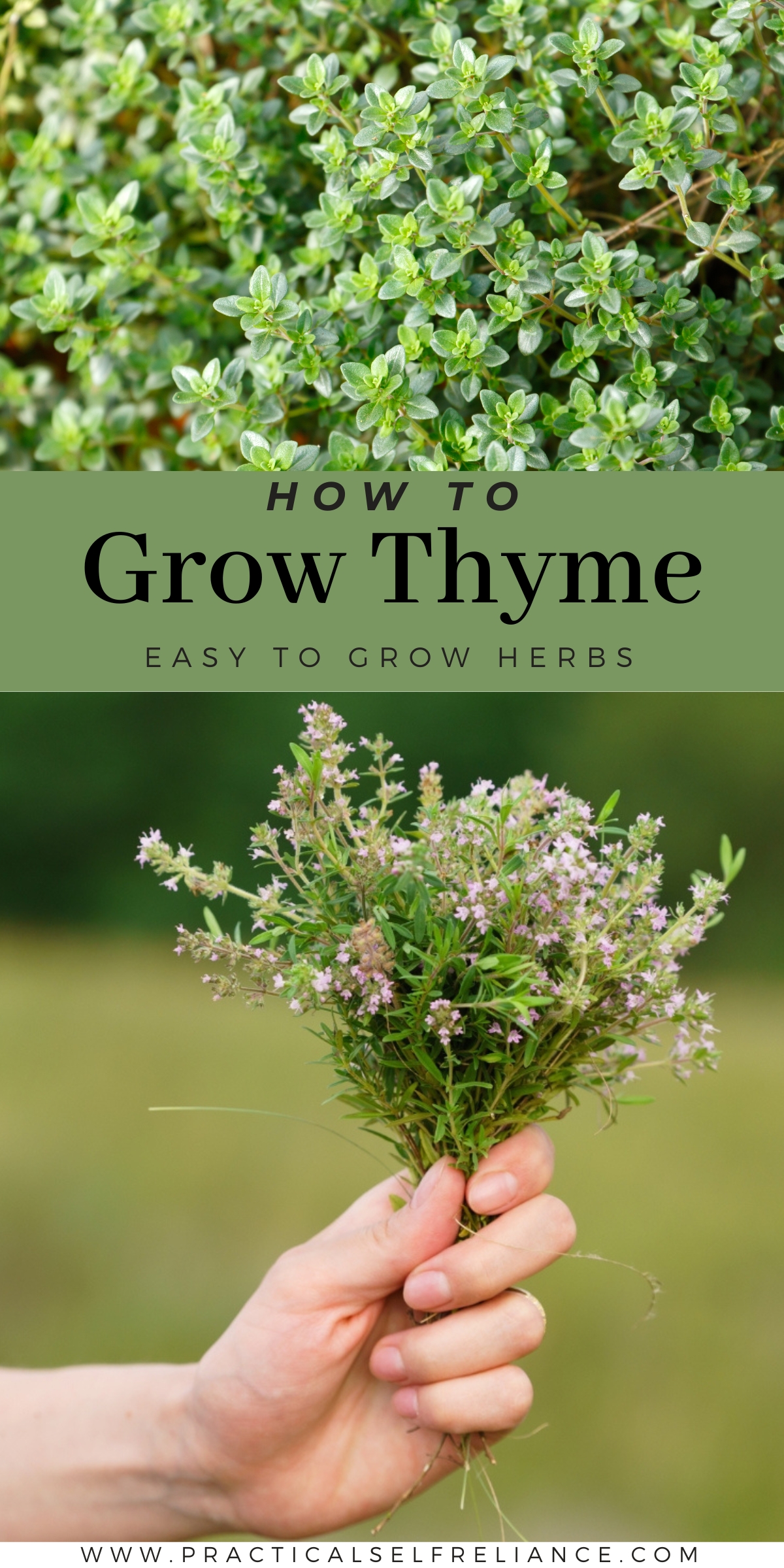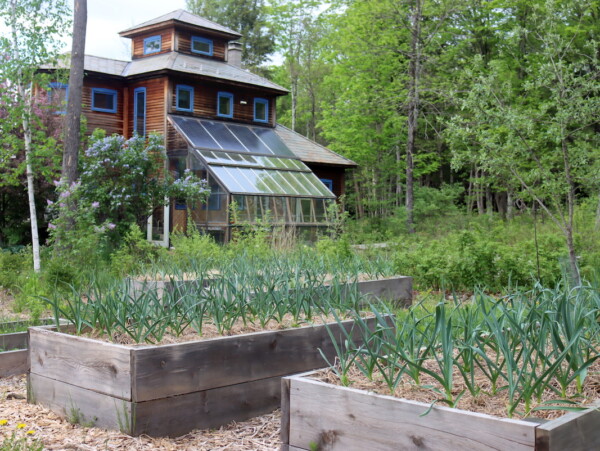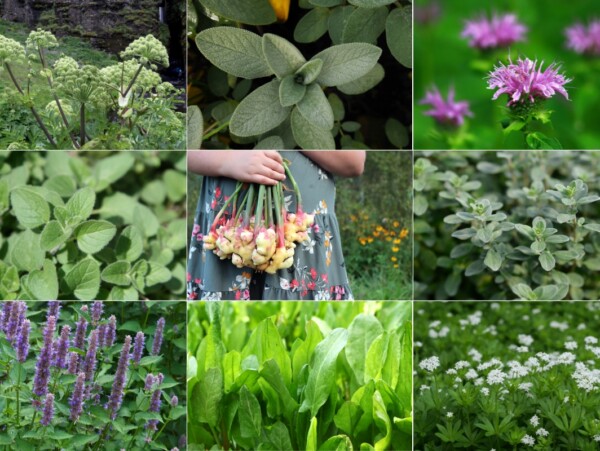Affiliate disclosure: This post may contain affiliate links. Please see our Privacy Policy.
Growing thyme is simple, and this easy-to-grow herb does well in containers or a small herb garden. Thyme plants can be prolific, and growing your own can save you quite a bit on fresh herbs at the grocery store.
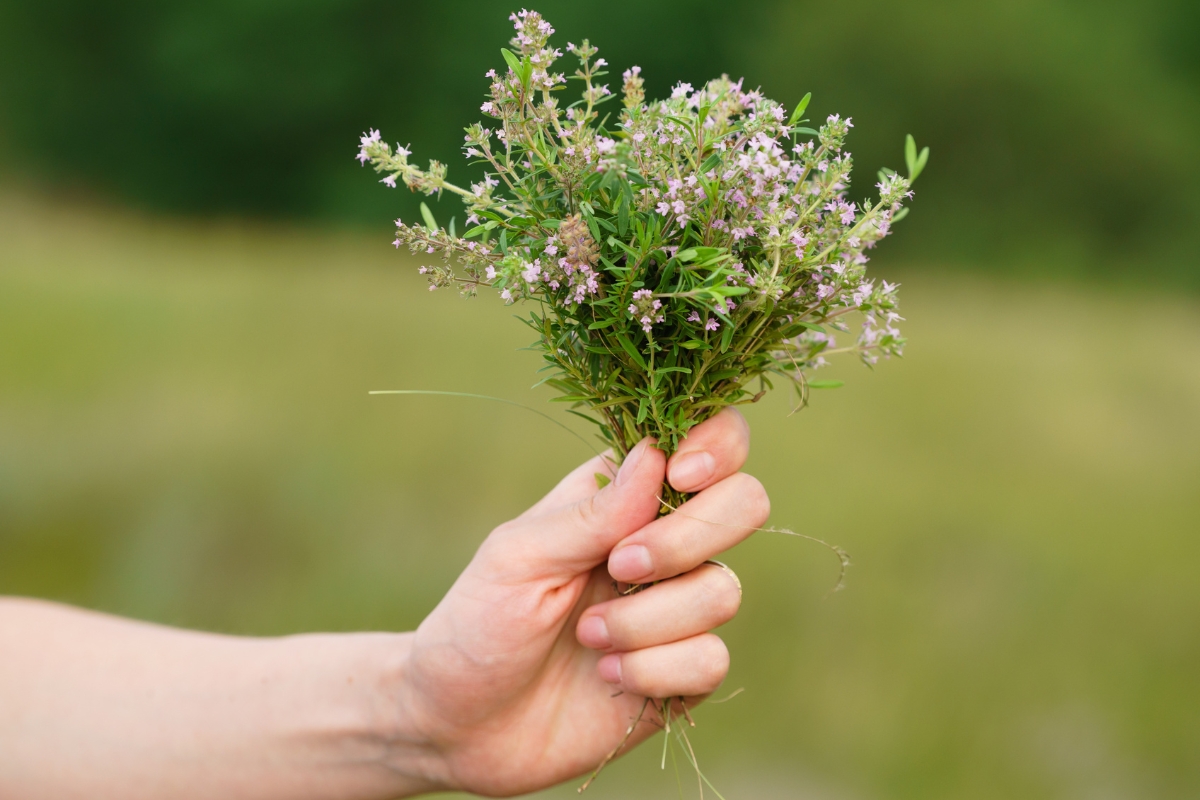
Thyme carpets the ground here on our Vermont homestead, where it’s escaped the herb bed and spread into the lawn and stream edges. I don’t mind, it’s a lovely ground cover that perfumes the whole yard and feeds the bees at the same time.
And anytime I need thyme, I can just step outside and harvest it beneath my feet.
Even if I never used it in the kitchen, I’d still grow thyme in my garden. This easy-to-grow herb plays an important role in attracting pollinators like bees and butterflies, feeding them all season long. Its small, aromatic flowers are a magnet for beneficial insects, which helps improve the overall health of my garden, too.
As an inobtrusive ground cover, its dense, low-growing habit makes it perfect for filling in spaces between stepping stones or as a living mulch to help suppress weeds. Plus, its fresh, herbal scent fills the air around your yard, making it a natural air freshener.
Thyme is a beautiful addition to any yard, whether planted in a dedicated herb garden, nestled between other flowers, used as a fragrant edging plant, or simply grown in a container on your patio.
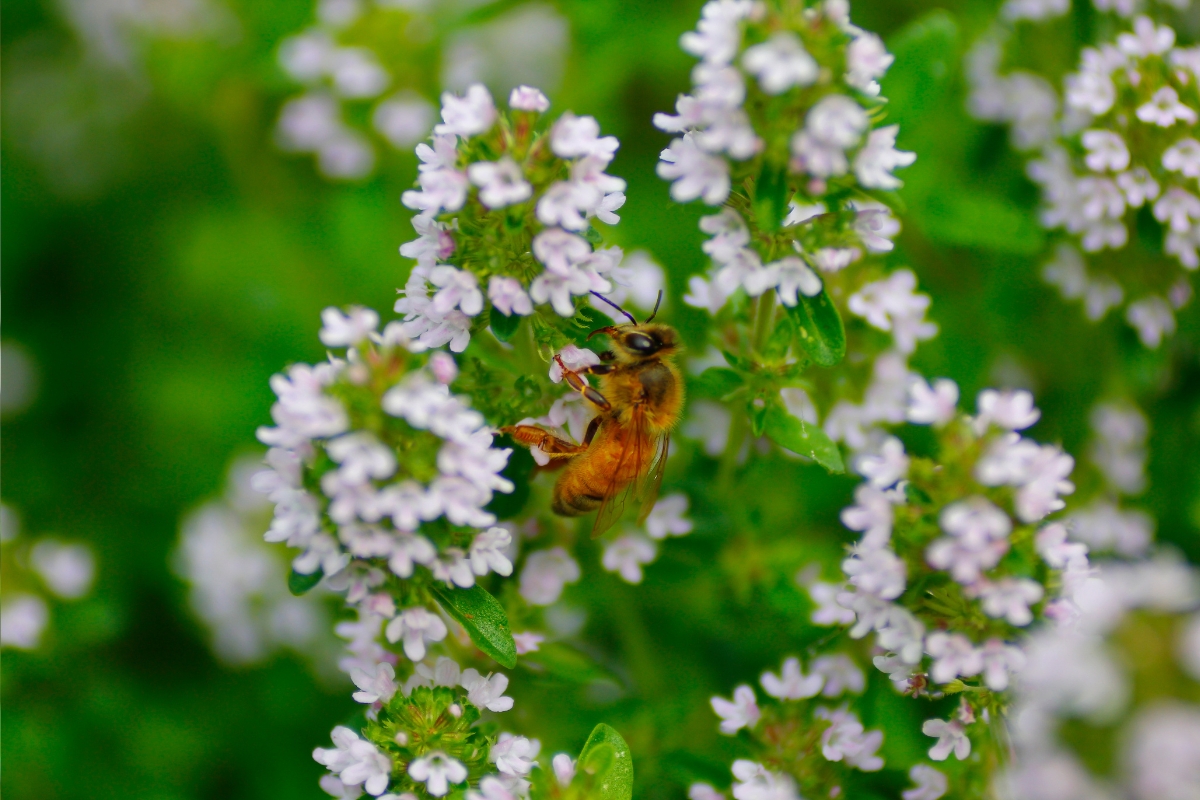
Choosing the Right Thyme Variety
Thyme (Thymus vulgaris) comes in many varieties, but the most commonly grown are English thyme and lemon thyme. English thyme is perfect for general culinary use, while lemon thyme adds a citrusy note to dishes like fish or chicken. Other varieties like creeping thyme or wild thyme can also be grown for ornamental purposes, creating fragrant ground covers or adding a touch of whimsy to your garden.
Before you plant, decide which variety suits your space and culinary preferences best. All types of thyme have similar growing requirements, so the care for them remains the same once you’ve made your choice.
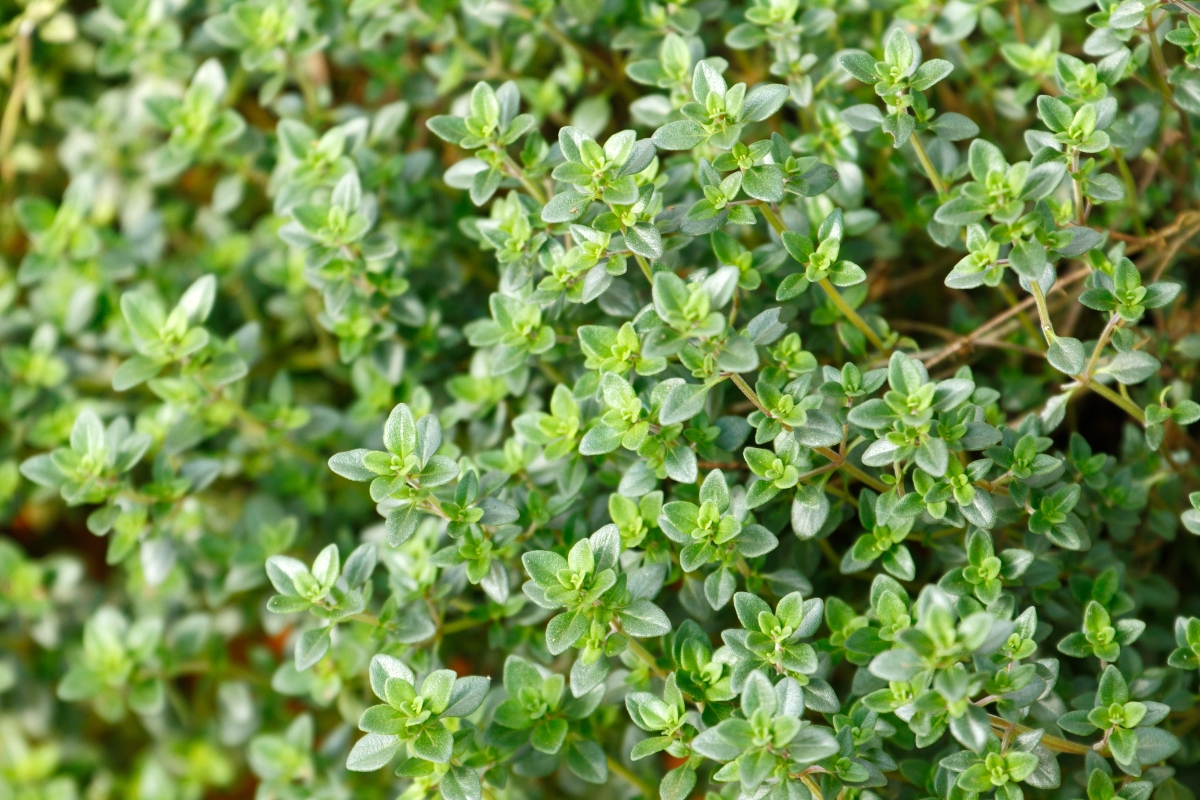
How to Grow Thyme
Thyme is a hardy and low-maintenance herb, making it a great addition to almost any garden. Whether you’re planting it in the ground or in a container, thyme is easy to grow and requires minimal attention. To get started, you can choose from a few different methods, depending on your preference and resources.
Planting from Seeds is a great option, especially if you’re looking to start from scratch. It’s best to begin thyme seeds indoors about 6–8 weeks before the last expected frost. Since thyme seeds are small, simply press them lightly into the soil without covering them too deeply. You can also sow them directly outdoors once the danger of frost has passed, but starting them indoors gives the plants a head start. Plant the seeds about ¼ inch deep for the best results.
If you’re looking for quicker results, consider planting from seedlings. You can easily find thyme seedlings at most nurseries or garden centers. This method eliminates the wait for germination and gives you a strong, healthy start. When transplanting seedlings, make sure to space them about 6–12 inches apart, as thyme plants can spread and grow quite bushy over time.
Another great way to grow thyme is by propagating it from cuttings, which is both easy and efficient if you already have a healthy thyme plant. To propagate, snip a healthy, non-flowering stem about 3–4 inches long, making the cut just below a set of leaves to ensure the cutting has a node (the part of the stem where roots will sprout). Strip the lower leaves off the cutting, leaving a few sets of leaves at the top to prevent rotting when placed in water or soil.
You can root the cutting either in water or soil. If you choose water, place the cutting in a jar of water, ensuring that the node is submerged. Change the water every couple of days, and after about 1–2 weeks, you should see roots starting to form. Alternatively, you can plant the cutting directly into moist potting soil, keeping it in a warm, sunny spot and watering lightly. Roots should develop within 2–3 weeks. Once the roots are well-established, you can carefully transplant the cutting into your garden or a container. Just be sure to handle the young plant gently to avoid damaging the delicate roots.
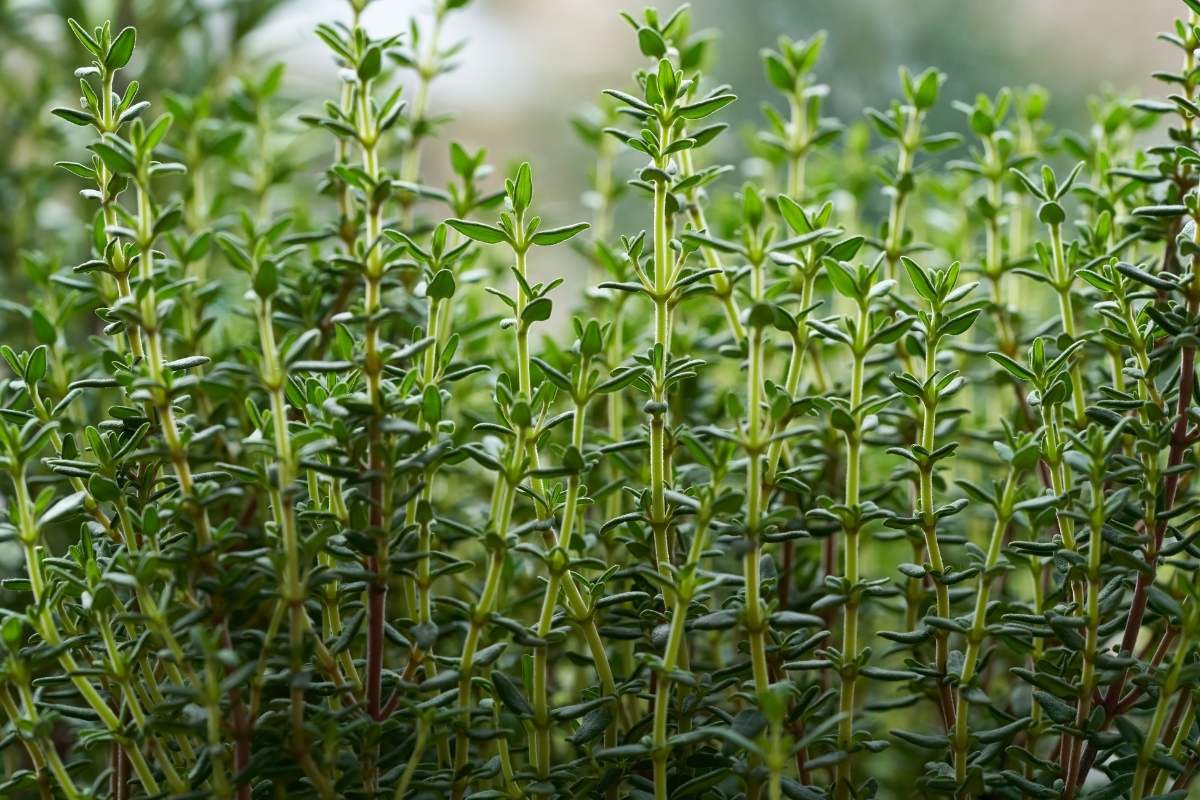
Where to Plant Thyme
Thyme is a sun-loving herb, so selecting the right location is essential for its healthy growth. It thrives when given plenty of sunlight and well-draining soil, so keep these factors in mind when choosing where to plant it.
Thyme requires at least 6–8 hours of direct sunlight per day to grow properly. A sunny garden bed or a south-facing windowsill are ideal spots for thyme, as they offer plenty of natural light. If you’re growing thyme indoors, a grow light can also provide the necessary exposure to ensure strong growth and vibrant leaves.
When it comes to soil type, thyme prefers soil that is well-draining and slightly alkaline. It does not tolerate soggy, waterlogged conditions, so good drainage is essential. If your soil is heavy or clay-based, improve drainage by mixing in sand or grit. Alternatively, thyme can be grown in containers filled with a well-draining potting mix, which is perfect for those with less-than-ideal garden soil.
While thyme is a relatively compact herb, it does appreciate some space to grow and spread. If planting in the ground, make sure to allow 6–12 inches of space between each plant to give it room to flourish and to ensure adequate air circulation. If growing in containers, choose a pot that is at least 6 inches deep and has drainage holes to prevent water from accumulating at the bottom and causing root rot.
Caring for Thyme Plants
Thyme is relatively low-maintenance, but it still requires some attention to ensure it thrives. Proper watering, fertilizing, and pruning practices will help your thyme plant flourish throughout the growing season.
When it comes to watering, thyme is quite drought-tolerant and prefers slightly dry conditions. Avoid over-watering, as one of the most common mistakes gardeners make with thyme is keeping the soil too moist. Always allow the soil to dry out between waterings, and ensure that it is well-drained to prevent root rot.
Thyme doesn’t require heavy feeding. In fact, too much fertilizer can lead to leggy, less flavorful plants. If your soil is particularly poor, you can add a balanced, slow-release fertilizer in the spring, but be careful not to overdo it. Thyme generally does well in relatively lean soil, and excessive fertilization can harm the plant’s natural flavor and growth.
Pruning is essential for maintaining a healthy thyme plant. Regularly prune to encourage bushier growth and remove any woody, leggy stems. Frequent harvesting of the leaves will prevent the plant from becoming sparse, but if you don’t plan to harvest regularly, be sure to cut back at least once a year to avoid the plant becoming too lanky and woody.
Although thyme is drought-tolerant, mulching around the base can help in certain conditions. Mulch can preserve moisture during hot, dry spells and help keep weeds at bay. Use a light, breathable mulch like straw or dried grass to avoid suffocating the plant’s roots while providing the benefits of moisture retention and weed control.
Harvesting Thyme
Once your thyme plant has grown strong and sturdy, you can begin harvesting. The best time to pick thyme is just before it starts flowering, usually in late spring or early summer, when the oils in the leaves are at their most potent.
To harvest, simply snip off the top 2–3 inches of the stems. The more you harvest, the bushier the plant will grow, so don’t be afraid to take a few sprigs. If you’re harvesting to use in cooking, it’s best to snip in the morning after the dew has dried but before the sun is too hot, as this is when the plant’s essential oils are most concentrated.
If you’re looking to dry thyme for later use, simply hang bunches upside down in a cool, dry place, or lay them flat on a drying rack. Thyme is one of the easiest herbs to dry, and it retains its flavor well when stored in an airtight container.
Common Pests and Problems
Thyme is relatively pest-resistant, but that doesn’t mean it’s immune to occasional problems.
- Spider Mites: These tiny pests are a common problem, especially in hot, dry conditions. They cause the leaves to turn yellow and become speckled. If you notice these symptoms, wash the leaves with a gentle stream of water or spray the plant with insecticidal soap.
- Powdery Mildew: While thyme is usually resistant to fungal diseases, too much humidity or overcrowding can lead to mildew. Ensure your plants have enough air circulation, and avoid watering from above to keep the leaves dry.
- Root Rot: The biggest threat to thyme comes from overwatering and poor drainage. Make sure your plant’s roots don’t sit in water for too long.
Overwintering Thyme
Thyme is hardy in USDA zones 4–8, meaning it can survive through the winter outdoors in many regions. If you live in a colder climate, consider bringing potted thyme indoors before the first frost to keep it alive throughout the winter. A sunny windowsill or an unheated porch works well. Just be sure to reduce watering during the colder months since thyme’s growth will slow down.
In milder climates, thyme will continue to grow year-round, though its growth may slow during the winter months.
Herb Growing Guides
Looking for more easy-to-grow herbs?
